Structure function and application of home telemedicine monitoring terminal based on ARM9 processor
Telemedicine is a product of the combination of network technology and medical technology. With the development of China's economy, the advancement of science and technology, and the need to enter an aging society, the development of telemedicine has become an inevitable trend. Telemedicine can be divided into: telemedicine systems for hospitals and telemedicine systems for families. The functions of the family-oriented telemedicine system include: remote "visiting doctors", remote monitoring, remote medical information inquiry/consulting, etc.
This article refers to the address: http://
Foreign remote family medical care pays more attention to remote “seeing doctorsâ€. Individuals/patients can communicate with doctors in real-time voice and image information at home, which can detect human physiological signals online and give diagnosis. This kind of system is based on the video conferencing system, but it is still difficult to popularize in China. The reason is that the price of the system is too expensive, and the average family cannot afford it. The second reason is that it is limited by the bandwidth of the communication channel. Digital Network (ISDN), which is now popular in China, is the Common Telephone System (POTS). Although two-way video transmission can be realized through this, it is difficult to achieve telemedicine in terms of image resolution and number of images transmitted per second. Requirements. As one of the important contents of telemedicine, remote monitoring transmits only human physiological signals, and the required communication speed can be satisfied by ordinary telephone lines. Therefore, considering the increasing trend of Internet users in China, the development of remote monitoring is more in line with China's national conditions.
System structure and function
The system adopts B/S (Browser/Server, browser/server) mode design. The biggest advantage of using this mode is to reduce the development workload and make operation and maintenance easier. Introducing the B/S mode into the embedded network design has changed the practice of developing both the upper computer and the lower computer software and hardware in the past. Now it is only necessary to integrate a micro server in the embedded device of the lower computer (server side), using HTML ( Hypertext Markup Language) By designing a webpage module, the template can be received and parsed by a browser such as IE on the host computer (browser side), thereby providing the user with a visual interface with good visual effect and convenient operation.
Firstly, based on ARM9 processor S3C2410A and embedded Linux operating system, a development platform supporting embedded Web Server is designed. Then, by embedding embedded Web Server-boa, with data acquisition and processing modules, a set of portable for home is constructed. Telemedicine monitoring terminal. In the monitoring terminal, the bioelectric electric guiding electrode is used to pick up the human body electrocardiographic signal by a standard three-lead method, and is transmitted to the signal conditioning module via the lead wire, and the primary bioelectric signal is obtained after filtering and amplifying the module, and then The S3C2410's own ADC pin is sent to the Web server module. The ECG signal is analyzed in various parameters in this module to obtain the signal reflecting the heart characteristics. The LCD displays the ECG waveform and the patient's personal information in real time. The electrical signal is stored in the off-chip Flash ROM, and the terminal accesses the Ethernet through the Ethernet port to implement remote interaction with the monitoring center. The system block diagram is shown in Figure 1.

Figure 1 system block diagram
Hardware circuit design
Signal conditioning circuit module
The detection of ECG signals is a weak signal detection under the background of strong noise. The signals are characterized by weak, low frequency, high impedance, instability and randomness. The main frequency range of this signal is 0.05~100Hz, and the amplitude range is 0.5~5mV. Weak ECG signals are also subject to multiple disturbances, and their features are submerged in complex signals. Moreover, since the bioelectrical guiding electrode contacts the human body when picking up the electric signal of the human body, a polarization voltage is generated. Therefore, in order to meet the detection requirements, the signal conditioning circuit must better suppress the amplified and undistorted amplified ECG signals. In this design, the signal conditioning circuit module mainly comprises a front end circuit, a signal amplifying circuit and a trap circuit. The circuit block diagram is shown in Figure 2.
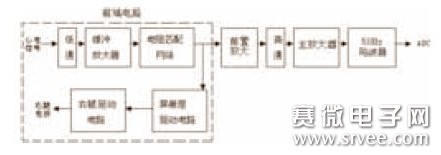
Figure 2 Signal conditioning circuit block diagram
Front end circuit
The front-end circuit is the first stage of the signal conditioning circuit. Its function is mainly to suppress the interference noise in the environment and improve the common mode rejection capability of the preamplifier. The buffer amplifier is generally implemented by a voltage follower. The buffer isolation reduces the excessive requirements of the biosignal to the amplifier, improves the input impedance of the circuit, and reduces the attenuation of the ECG signal and the matching distortion. The use of the shield drive circuit can better remove the influence of the unequal attenuation of the distributed capacitance of the lead wire shield on the total CMRR (common mode rejection ratio) of the amplifier. Since the human body can pick up the power frequency 50Hz AC voltage from the environment through various channels, the AC common mode interference is formed in the ECG measurement. This interference is often above several volts, and the 50Hz common mode interference voltage can be made after the right leg drive circuit is used. Drop below 1%. The circuit diagram is shown in Figure 3.
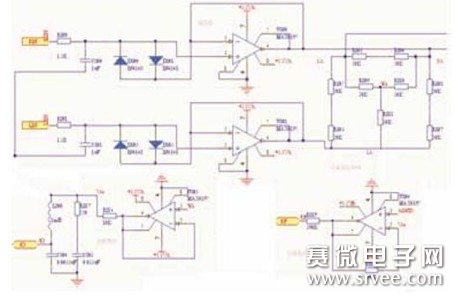
Figure 3 front end circuit
Signal amplifier circuit
The signal amplifying circuit adopts two-stage amplification, as shown in FIG. 4, the differential amplification U805 is a pre-stage, and the in-phase amplification U809 constitutes a second stage. Depending on the characteristics of ECG signal detection, amplifiers are typically required to have high input impedance, high common-mode rejection ratio, low noise, low drift, low nonlinearity, proper frequency band and dynamic range performance. The input resistance of the preamplifier is generally required to be >2 megaohms. The larger the input resistance, the smaller the waveform distortion caused by the difference in electrode contact resistance, and the higher the common mode rejection ratio. Due to the presence of the polarization voltage, in order to prevent the preamplifier from operating in the saturation or cut-off region, the gain of the pre-stage cannot be too high, and experiments have shown that the amplification is about 10 times better. Therefore, the instrumentation amplifier MAX4196 is used. The chip can be powered by a single power supply. The power consumption is up to 8mA, the common mode rejection ratio is 115dB, the input offset voltage is 50mV, the -3dB bandwidth is up to 250kHz, the input impedance is 1000MW, and the gain is fixed at 10 (V/V).

Figure 4 two-pole amplification and filter circuit
The total common mode rejection ratio of the preamplifier section is:

among them:  Amplifier closed-loop differential mode gain, Ac: common mode gain, CMRRD: value of the op amp itself; CMRRR: CMRR defined by external circuit resistance matching accuracy, d: resistance accuracy. Therefore, in the circuit, the external circuit resistance R812=R813 should be precisely matched to make the common mode output smaller.
Amplifier closed-loop differential mode gain, Ac: common mode gain, CMRRD: value of the op amp itself; CMRRR: CMRR defined by external circuit resistance matching accuracy, d: resistance accuracy. Therefore, in the circuit, the external circuit resistance R812=R813 should be precisely matched to make the common mode output smaller.
The main amplifier uses the MAX4197 (characteristically the MAX4196) with a fixed gain of 100 (V/V). The total magnification of the signal conditioning circuit is 1000 times. In FIG. 4, the capacitor C805 has a function of removing the polarization voltage, and forms a high-pass filter circuit with the resistor R820 for suppressing DC drift and low-frequency noise outside the passband of the amplifier.
Trap circuit
Power frequency interference is the main interference of ECG signals. Although the front-end circuit and pre-amplifier have strong suppression of common mode interference, some power frequency interference is the differential mode signal entering the circuit, and the frequency is in the heart. Within the frequency band of the electrical signal, plus the instability of the electrode and the input loop, the ECG signal output from the preamplifier circuit still has strong power frequency interference, so it must be filtered out. This design uses an infinite gain multi-feedback type second-order notch filter, the circuit is shown in Figure 5.
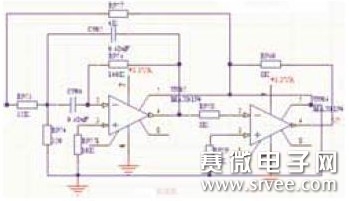
Figure 5 trap circuit
Embedded web server module
Considering that the system is positioned for home use, and the system needs to work continuously for a long time, and because the system needs a good human-computer interaction environment, stores a large amount of data, and supports network communication, the processor is required to have low power consumption, low cost, and rich interface. And support for the operating system. This design uses ARM9 processor S3C2410A, S3C2410A is mainly for handheld devices and cost-effective, low-power applications. Its CPU core uses ARM's 16/32-bit ARM920T RISC processor. The ARM920T implements the MMU, AMBA bus, and Harvard cache architecture with a separate 16KB instruction cache and 16KB data cache. The integrated on-chip functions of the S3C2410A include: 1.8V/2.0V core supply, 3.3V memory supply, 3.3V external I/O supply; external memory controller; LCD controller provides 1-channel LCD dedicated DMA; 8-channel 10-bit ADC interface The conversion rate is up to 500KSPS (Kilo Sample Per Second); 117-bit general-purpose I/O port and 24-channel external interrupt source; power control mode includes normal, slow, idle and power-down modes; Support for boot load of NAND Flash.
The sampling accuracy of the ECG signal is mainly due to the requirements of the ST segment anomaly analysis processing. The ST segment level change is about 0.05 mV, so the sampling accuracy is at least 0.025 mV. When the 10-bit A/D converter is used for positive polarity and the full-scale voltage is 2.5V, the minimum resolution of the input voltage is 2.5mV, and the signal conditioning circuit is 1000 times magnification. The minimum resolution of the input is about 0.0025mV, so the S3C2410A has a 10-bit A/D accuracy that fully meets the system requirements.
In order to enable users to visually observe the ECG and facilitate the control of the device, the design uses Donghua's TFT color screen YL-LCD35 kit for human-computer interaction interface. In order to meet the requirements of porting the operating system and storing data such as ECG signals and web pages, the system has expanded 64M NAND Flash (using one K9F1208UOB) and 64M SDRAM (using two HY57V561620). To meet the needs of terminal networking, the CS8900A is designed to design network adapters. The CS8900A is a true single-chip, full-duplex Ethernet solution. It is more convenient to provide drivers for the CS8900A adapter in the Linux kernel.
Power section
In order to increase safety, reduce power consumption and save cost, the design is powered by a 9V alkaline battery. The power conversion chip AS1117-3.3 converts 9V to 3.3V for use in amplifier chips and S3C2410.
software design
The software design mainly includes the transplantation of Linux, the transplantation of embedded Web Server-Boa, the design of CGI (Common Gateway Interface) program, and the design of functional programs.
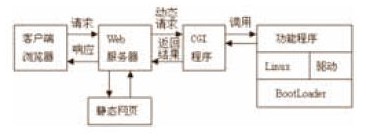
Figure 6 system software block diagram
Linux porting
This design uses the linux-2.4.18 kernel. The prerequisite for proper Linux porting is to have a BootLoader that is compatible with Linux and easy to use. It can correctly complete hardware system initialization and Linux boot. This system uses vivi, which is a BootLoader for S3C2410 chip provided by MIZI of South Korea.
The Linux kernel directory /arch contains all the kernel porting code associated with the hardware architecture. Each subdirectory in the directory /arch represents a Linux supported processor. Porting Linux to the S3C2410 platform is mainly to modify the relevant makefile and configuration files in the /arch/arm directory and its subdirectories. For example: modify the Makefile in the kernel root directory, indicating that the hardware platform to be ported is ARM: ARCH:=arm, indicating the cross compiler CROSS_COMPILE=/opt/host/armv41/bin/armv41-unknown-linux-; The config.in file in the arm/arm directory is configured with information about the S3C2410. To initialize the processor, you also need to add the head-s3c2410.s file in the arch/arm/boot/compressed directory. After the kernel is modified, use the make menuconfig command to configure Linux, and then use the make zImage command to compile the kernel. After compiling, the zImage kernel file is generated in the directory arch/arm/boot. The cramfs file system must be created using the tool software MKCRAMFS. Finally, the kernel and file system are downloaded to the target system using the load command in the vivi command line of the minicom terminal, and the migration is completed.
Boa porting and CGI programming
Because embedded devices have limited resources and do not need to respond to multi-user requests at the same time, some specialized web servers are typically used for embedded application design. Boa is a single-tasking web server with open source code, high performance, support for CGI, and a CGI program fork for execution. The design goal is speed and security, and the executable code is only about 60KB. The process of porting Boa is as follows: download boa-0.94.13 from sourceforge.net, generate and modify the makefile in its unzipped directory, then run make to get the executable program, and use the command armv4l-unknown-linux-strip to strip the debugging information. Go and modify Boa's configuration file boa.conf to support the running of CGI programs. Finally, the generated executable program Boa is mounted to the target system. If the static HTML web page and the CGI program for running the test are successfully accessed, the configuration is successful.
The universal gateway interface CGI can connect the web server to the external application. It mainly accomplishes two things: one is to collect the information sent from the web browser to the web server, and provide the information to the external program for use; the second is to make a request. The web browser sends the output of the program. CGI has the advantages of platform independence, language independence and layering. With CGI programs, dynamic information can be executed and output in real time, and it takes up less resources. The execution process of the CGI program is: the browser submits the form data to the web server by the POST method, the server sets the environment variable according to the received data, and newly opens a child process to execute the CGI program, and the CGI program reads the environment variable from the environment. The required data is processed by calling the user-defined external function function, and then the corresponding HTML template file is read, and the corresponding data is filled into the HTML file according to the comment mark, and a new HTML page is generated and returned to the web server. Browser.
In order to quickly develop CGI programs that meet application requirements, CGIC libraries and gd libraries have been added at design time. CGIC is a powerful open source standard C library that supports CGI development. The gd library written by Thomas Boutell is a standard C language library with basic drawing and other functions. In order to dynamically display the ECG waveform on the webpage, each acquired data is sent to the CGI program after being processed by the function program, and the function provided by the gd library is used to create the image. The dynamic display of the electrocardiogram waveform on the web page is realized by setting the refresh time (using the META mark of the HTML language) on the webpage module.
Main program design
The main program first completes the initialization of the system, and then blocks whether the network interface has a connection request. Once the client sends a connection request, it generates an interrupt on the server side; reads the network data, and then parses the network data. This step is mainly to analyze The HTTP protocol needs to determine whether the connection request conforms to the request format specified by the server, determine the request method of the connection request, determine whether the requested file exists on the server, determine whether the authentication information is correct, or the like; and process the data collected by the A/D. In the process, the collected ECG signal should be filtered firstly, mainly to suppress the 50Hz power frequency interference in the ECG signal. After the filtering is completed, the data is sent to the local LCD for display, and the current data is The format of the web page data is sent to the network port.
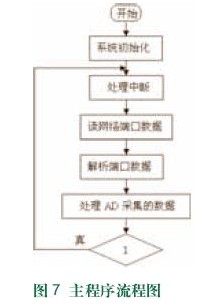
Conclusion
The design of the system is targeted at home medical monitoring, and the monitoring system for remote home medical is realized by integrating the Web server into the embedded system for physiological characteristic information monitoring to realize Internet access. The significance lies in: designing a set of remote family medical monitoring system with low price and easy to promote, changing the current situation of backward family medical monitoring in China; effectively improving the monitoring level of chronic diseases such as cardiovascular in middle-aged and elderly people, which is conducive to improving the middle-aged and elderly people. The overall treatment rate of patients with sudden illness; provide medical institutions with a large number of valuable raw data on the disease of middle-aged and elderly people in China for scientific research.
Toaster, is a commonly used kitchen supplies, mainly used to bake bread. A toaster usually includes a multi-functional oven, a heat-insulating surface, a special lifting device, etc. The more advanced also includes a separable breadcrumb chassis. The toaster is a heating appliance. Its function is to generate enough heat in the vicinity of the bread to bake the bread. If there is no pop-up toaster, breakfast will certainly not be so rich nowadays.
In many families, the toaster is more prone to failure than any other small home appliance. There are two reasons for this. First of all, the toe machine manufacturing costs are generally very low, its quality is not high. You can replace a new device with just $ 10.
Second, the toaster is often not a problem when their own failure, but the food particles interfere with its normal operation. If there are too many slices of bread on the bracket, they will fall into the bottom of the toaster and accumulate when the movement of the tray will move up, thus hindering the movement of the bracket, causing the heating element to short circuit, Open the device and affect the function of the spiral tube.
Most of the pop-up toasters are equipped with a large debris plate and have a door at the bottom, the reason for this. By sliding or opening the broken door, you can clean up the food particles that accumulate at the bottom of the toaster.
Electric Bread Maker,Home Bread Maker,Automatic Bread Maker,Portable Bread Maker
Ningbo APG Machine(appliance)Co.,Ltd , http://www.apgelectrical.com